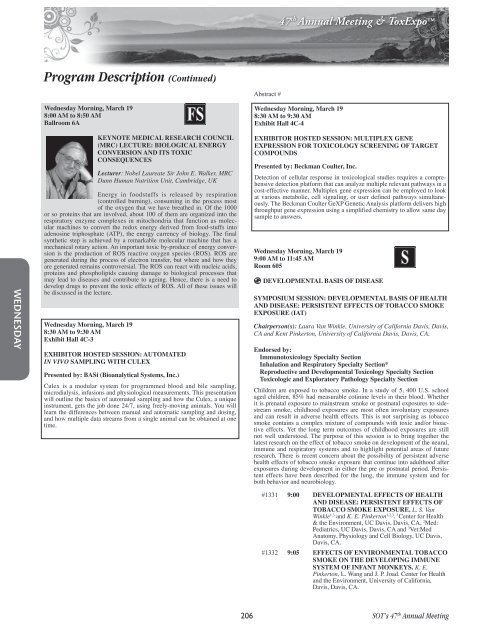Annual Meeting Program - Society of Toxicology
Annual Meeting Program - Society of Toxicology
Annual Meeting Program - Society of Toxicology
You also want an ePaper? Increase the reach of your titles
YUMPU automatically turns print PDFs into web optimized ePapers that Google loves.
47 th <strong>Annual</strong> <strong>Meeting</strong> & ToxExpo<br />
<strong>Program</strong> Description (Continued)<br />
Abstract #<br />
Wednesday Morning, March 19<br />
8:00 AM to 8:50 AM<br />
Ballroom 6A<br />
Wednesday Morning, March 19<br />
8:30 AM to 9:30 AM<br />
Exhibit Hall 4C-4<br />
Wednesday<br />
Keynote Medical Research Council<br />
(MRC) Lecture: Biological Energy<br />
Conversion and its Toxic<br />
Consequences<br />
Lecturer: Nobel Laureate Sir John E. Walker, MRC<br />
Dunn Human Nutrition Unit, Cambridge, UK<br />
Energy in foodstuffs is released by respiration<br />
(controlled burning), consuming in the process most<br />
<strong>of</strong> the oxygen that we have breathed in. Of the 1000<br />
or so proteins that are involved, about 100 <strong>of</strong> them are organized into the<br />
respiratory enzyme complexes in mitochondria that function as molecular<br />
machines to convert the redox energy derived from food-stuffs into<br />
adenosine triphosphate (ATP), the energy currency <strong>of</strong> biology. The final<br />
synthetic step is achieved by a remarkable molecular machine that has a<br />
mechanical rotary action. An important toxic by-produce <strong>of</strong> energy conversion<br />
is the production <strong>of</strong> ROS reactive oxygen species (ROS). ROS are<br />
generated during the process <strong>of</strong> electron transfer, but where and how they<br />
are generated remains controversial. The ROS can react with nucleic acids,<br />
proteins and phospholipids causing damage to biological processes that<br />
may lead to diseases and contribute to ageing. Hence, there is a need to<br />
develop drugs to prevent the toxic effects <strong>of</strong> ROS. All <strong>of</strong> these issues will<br />
be discussed in the lecture.<br />
Wednesday Morning, March 19<br />
8:30 AM to 9:30 AM<br />
Exhibit Hall 4C-3<br />
Exhibitor Hosted Session: Automated<br />
In Vivo Sampling with Culex<br />
Presented by: BASi (Bioanalytical Systems, Inc.)<br />
Culex is a modular system for programmed blood and bile sampling,<br />
microdialysis, infusions and physiological measurements. This presentation<br />
will outline the basics <strong>of</strong> automated sampling and how the Culex, a unique<br />
instrument, gets the job done 24/7, using freely-moving animals. You will<br />
learn the differences between manual and automatic sampling and dosing,<br />
and how multiple data streams from a single animal can be obtained at one<br />
time.<br />
Exhibitor Hosted Session: Multiplex Gene<br />
Expression for <strong>Toxicology</strong> Screening <strong>of</strong> Target<br />
Compounds<br />
Presented by: Beckman Coulter, Inc.<br />
Detection <strong>of</strong> cellular response in toxicological studies requires a comprehensive<br />
detection platform that can analyze multiple relevant pathways in a<br />
cost-effective manner. Multiplex gene expression can be employed to look<br />
at various metabolic, cell signaling, or user defined pathways simultaneously.<br />
The Beckman Coulter GeXP Genetic Analysis platform delivers high<br />
throughput gene expression using a simplified chemistry to allow same day<br />
sample to answers.<br />
Wednesday Morning, March 19<br />
9:00 AM to 11:45 AM<br />
Room 605<br />
Developmental Basis <strong>of</strong> Disease<br />
SYMPOSIUM SESSION: DEVELOPMENTAL BASIS OF HEALTH<br />
AND DISEASE: PERSISTENT EFFECTS OF TOBACCO SMOKE<br />
EXPOSURE (iat)<br />
Chairperson(s): Laura Van Winkle, University <strong>of</strong> California Davis, Davis,<br />
CA and Kent Pinkerton, University <strong>of</strong> California Davis, Davis, CA.<br />
Endorsed by:<br />
Immunotoxicology Specialty Section<br />
Inhalation and Respiratory Specialty Section*<br />
Reproductive and Developmental <strong>Toxicology</strong> Specialty Section<br />
Toxicologic and Exploratory Pathology Specialty Section<br />
Children are exposed to tobacco smoke. In a study <strong>of</strong> 5, 400 U.S. school<br />
aged children, 85% had measurable cotinine levels in their blood. Whether<br />
it is prenatal exposure to mainstream smoke or postnatal exposures to sidestream<br />
smoke, childhood exposures are most <strong>of</strong>ten involuntary exposures<br />
and can result in adverse health effects. This is not surprising as tobacco<br />
smoke contains a complex mixture <strong>of</strong> compounds with toxic and/or bioactive<br />
effects. Yet the long term outcomes <strong>of</strong> childhood exposures are still<br />
not well understood. The purpose <strong>of</strong> this session is to bring together the<br />
latest research on the effect <strong>of</strong> tobacco smoke on development <strong>of</strong> the neural,<br />
immune and respiratory systems and to highlight potential areas <strong>of</strong> future<br />
research. There is recent concern about the possibility <strong>of</strong> persistent adverse<br />
health effects <strong>of</strong> tobacco smoke exposure that continue into adulthood after<br />
exposures during development in either the pre or postnatal period. Persistent<br />
effects have been described for the lung, the immune system and for<br />
both behavior and neurobiology.<br />
#1331 9:00 DEVELOPMENTAL EFFECTS OF HEALTH<br />
AND DISEASE: PERSISTENT EFFECTS OF<br />
TOBACCO SMOKE EXPOSURE. L. S. Van<br />
Winkle 1,3 and K. E. Pinkerton 1,2,3 . 1 Center for Health<br />
& the Environment, UC Davis, Davis, CA, 2 Med:<br />
Pediatrics, UC Davis, Davis, CA and 3 Vet:Med<br />
Anatomy, Physiology and Cell Biology, UC Davis,<br />
Davis, CA.<br />
#1332 9:05 EFFECTS OF ENVIRONMENTAL TOBACCO<br />
SMOKE ON THE DEVELOPING IMMUNE<br />
SYSTEM OF INFANT MONKEYS. K. E.<br />
Pinkerton, L. Wang and J. P. Joad. Center for Health<br />
and the Environment, University <strong>of</strong> California,<br />
Davis, Davis, CA.<br />
206<br />
SOT’s 47 th <strong>Annual</strong> <strong>Meeting</strong>
















